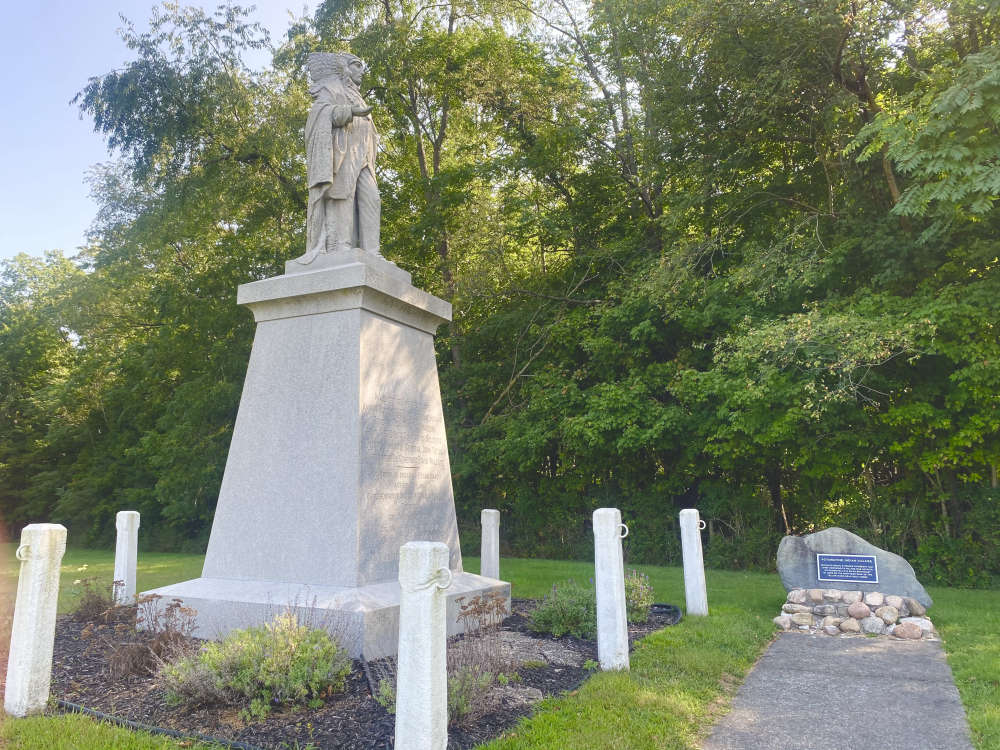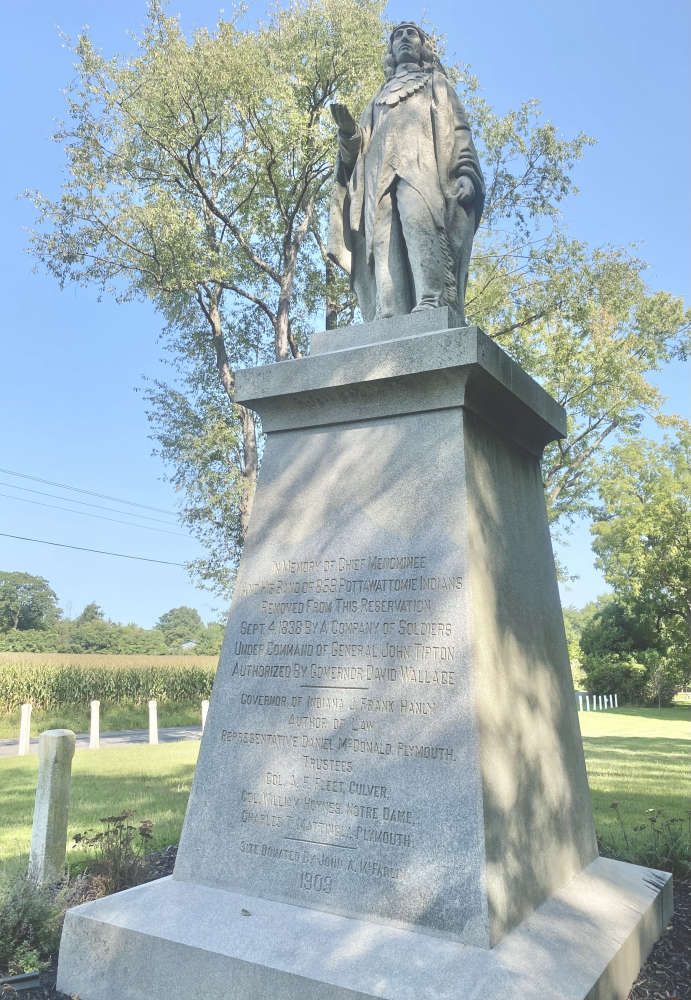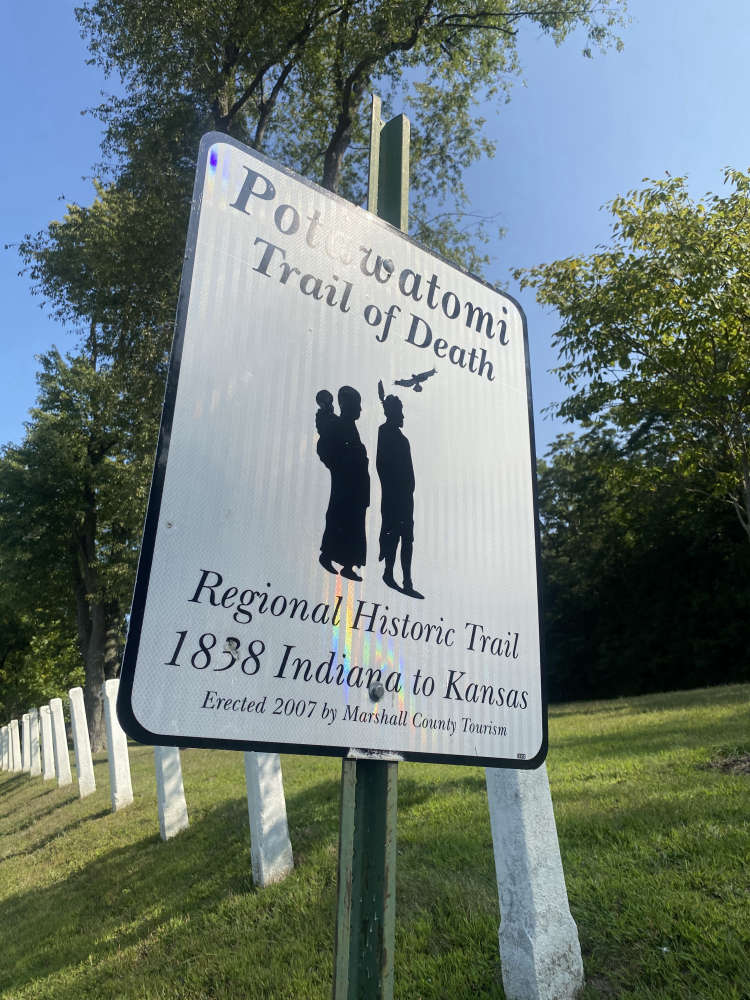
It's been 186 years since the forced removal of Native Americans from Indiana, in what would later be dubbed the Trail of Death. The 17-foot tall granite statue of Chief Menominee in rural Marshall County was the first monument dedicated by the state of Indiana to Native Americans in 1909 and stands as a reminder of the Potawatomi presence the community once had.
This month marks 186 years since the forced removal of of the Potawatomi from Indiana to Kansas. A statue of Chief Menominee at 12380 Peach Road, five miles southwest of Plymouth, however, stands as a reminder of the tragic oppression the Native Americans had to endure.
The 17-foot tall granite statue for Menominee was dedicated on Sept. 4, 1909, and includes a small park around the monument. The Menominee statue was the first monument dedicated by the state of Indiana to a Native American erected under a state or federal legislative enactment, in remembrance of the horror the Potawatomi tribes were put through. Remains of stones from a log replica chapel that burned in 1920 also still stands at the park.

The area of the site near present day Myers Lake and Cook Lake stood as a gathering place in 1838 for the Potawatomi tribe members who refused to be removed from their Indiana reservation lands. Prior to the tribes removal, Menominee's name had appeared on multiple land cession treaties with the US government, despite Menominee and several other Potawatomi's refusing to take part in any land cession negotiations. President Andrew Jackson had encouraged Congress to pass the Indian Removal Act in 1830, providing the federal government the authority to acquire Native American lands in eastern states in exchange for territorial lands west of the Mississippi River. The negotiations Menominee refused had included the 1836 Treaty of Yellow River, which directly had led to the violent, forced removal of 859 Potawatomi's from Indiana on Sept. 4, 1838.

Resources highlighting the Trail of Death by the potawatomi.org stated the removal would later be recognized as the largest recorded Native American removal from Indiana. For the next two months, the Native Americans were held at gunpoint and forced to marched 660 miles in a single-file line to Osawatomie, Kansas, a journey that would eventually become known as the Trail of Death. Due to the harsh weather during their travels, 42 Potawatomi tribe members would lose their lives along the route, 28 of those being children. Though he survived the march to Kansas, Menominee died less than three years after his removal from Indiana.

The tribe still lives on, however, thanks to the Citizen Potawatomi Nation, a successor of the Potawatomi who were located originally in Indiana's Wabash River Valley. In modern times, the Citizen Potawatomi Nation stands as a federally recognized tribe and have headquarters located in Shawnee, Oklahoma. Enrollment to the tribe is based on lineal descent, but the tribe has no minimum blood quantum.
What also lives on locally to help keep history alive is the 48th annual Trail of Courage Living History Festival, which will be going on this weekend, Sept 21 and 22, at at the Fulton County Historical Society grounds – four miles north of Rochester at U.S. 31 and County Road 375 North.
Hours are 10 a.m.-6 p.m. Saturday and 10 a.m.-4 p.m. Sunday. Cost to enter the event is $10 for adults, $5 for ages 6 to 11, and free to children 5 and younger.
Melinda Clinger has been the Fulton County Museum Director for the past 43 years and says the festival is held to commemorate the time period before the forced removal of the Native Americans. Clinger said each year brings about 13,000 visitors to the festival, which features food cooked over wood fires, muzzleloading contests, period music and dance, traditional crafts, historic camps and trading, canoe rides on the Tippecanoe River and more.
“We do this every year to help people remember what happened. It was a tragedy how they were removed. Chief Menominee, among other chiefs that led tribes from Indiana and Michigan, were taken from Rochester by jail wagon. It's something we shouldn't ever forget,“ Clinger said.




 Pizza Inn holds grand opening at its Rochester location
Pizza Inn holds grand opening at its Rochester location
 Governor Braun takes action to waive hours-of-service regulations for transporting propane
Governor Braun takes action to waive hours-of-service regulations for transporting propane
 Two Indiana State Fair Commission executives elected to prominent national IAFE Positions, Indiana State Fair honored with multiple awards
Two Indiana State Fair Commission executives elected to prominent national IAFE Positions, Indiana State Fair honored with multiple awards
 Cover Crop Premium Discount Program available for Hoosier farmers, new pre-enrollment available
Cover Crop Premium Discount Program available for Hoosier farmers, new pre-enrollment available
 Carlos Plascencia named Fulton County Community Foundation 2026 Lilly Endowment Community Scholarship recipient
Carlos Plascencia named Fulton County Community Foundation 2026 Lilly Endowment Community Scholarship recipient
 Citizens Police Academy to be hosted by Starke County Sheriff's Office
Citizens Police Academy to be hosted by Starke County Sheriff's Office
 Indiana FSSA extends open enrollment for HIP and PathWays Plans through December 24
Indiana FSSA extends open enrollment for HIP and PathWays Plans through December 24
 Consumer Alert: Dozens of dangerous products recalled in November
Consumer Alert: Dozens of dangerous products recalled in November



